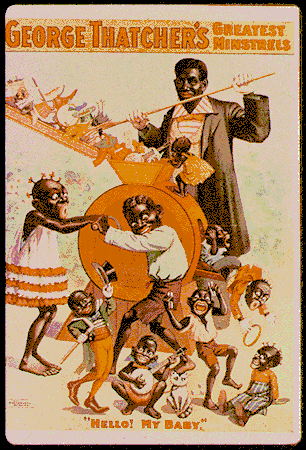|

Detail:
Rustic Dance After Sleigh Ride. William Sidney Mount. 1830
A forerunner of 19th-century
"sambo" paintings: grinning, red-lipped, clown-like African American
entertainers.
�@

Minstrel Show advertisement
What
stereotypes of African American people does the advertisement
illustrate?
�@

Minstrel show characters

Minstrel show actors
were both whites and African Americans in "black face" makeup.
�@

�@

�@
"We wear the mask
that grins and lies..."
--Paul Laurence Dunbar, "We Wear the
Mask"

Robert
Lee MacCameron. New Orleans Darkey. ca. 1910.
Is
this figure naturalistically portrayed, or is it stereotypical? Is the
title a clue?
How does it illustrate Dunbar's
poem?
�@

William
Sidney Mount. The Bone Player. 1856
Is
this portrait stereotypical or not?
�@
 |
�@
�@
|

Eastman
Johnson. Fiddling His Way. 1866. (Detail
right)
Portrait
of an itinerant musician.
Is the portrait stereotypical?
Note
the musician's position and "status" among the white listeners; are
they similar to that of the fiddler in Rustic Dance (top of page)? Or
is there a difference?
�@

Henry
Tanner. The Banjo Lesson (1893)
|
